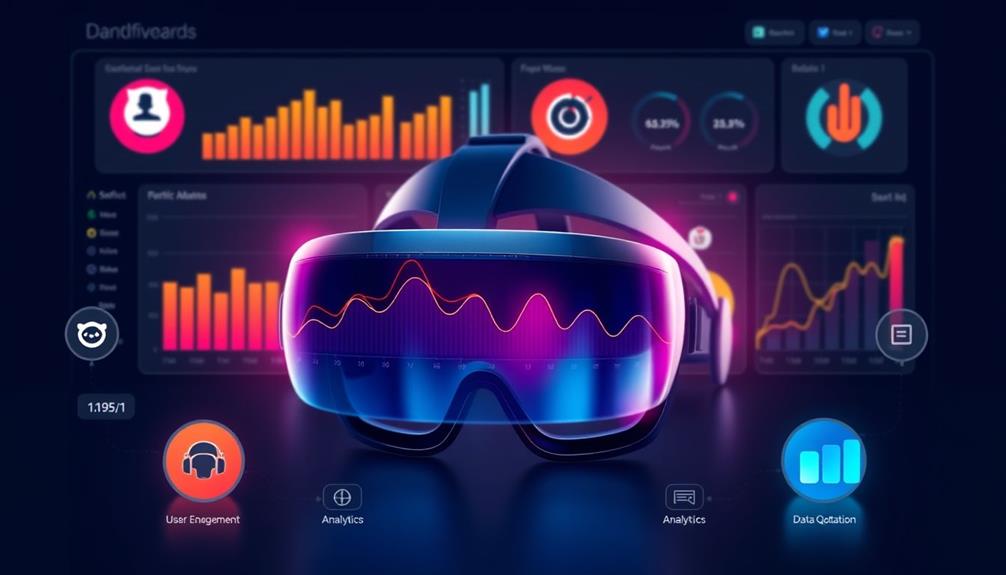To maximize SEO for virtual and augmented reality experiences, you need to focus on boosting visibility and user engagement. Start by optimizing keywords in your page titles, meta descriptions, and headings. Address unique challenges like large file sizes and mobile compatibility to improve loading times and accessibility. Incorporate interactive elements to enhance user retention, and use analytics to track engagement metrics. Don't forget about the importance of a mobile-friendly design, as most users access AR content on their smartphones. There's much more to explore about optimizing your VR and AR content for search engines effectively.
Key Takeaways
- Optimize page titles, meta descriptions, and headings with relevant keywords to improve visibility of VR and AR content.
- Implement mobile-friendly designs to enhance user experience and accessibility for smartphone users accessing immersive experiences.
- Utilize compression techniques and efficient file formats to reduce large file sizes, improving loading times and performance.
- Monitor user engagement metrics like bounce rates and time on site to refine content and boost SEO rankings.
- Regularly assess and update SEO strategies to align with search engine algorithm changes and improve discoverability.
Understanding VR and AR
When you explore the world of Virtual Reality (VR) and Augmented Reality (AR), it's vital to understand their distinct characteristics. VR offers fully immersive experiences, often requiring specialized headsets to transport you to simulated environments. In contrast, AR overlays digital content onto your real world, usually accessed through smartphones or AR glasses. The integration of technologies like geothermal energy can further enhance these experiences by providing sustainable power solutions for VR and AR devices.
The applications of VR are primarily found in gaming and exploration, providing thrilling adventures and unique experiences. On the other hand, AR enhances real-life situations, making it invaluable in areas like navigation, virtual try-ons, and interactive content marketing.
Both technologies push user engagement to new heights, creating opportunities for businesses to connect with customers in innovative ways.
Major tech companies are heavily investing in AR, anticipating a global market projection of around $209 billion by the end of 2022. This investment signals AR's potential to revolutionize digital marketing strategies and boost local business visibility through engaging, location-based experiences.
As you dive deeper into VR and AR, you'll see how they can transform industries, with VR advancing gaming and healthcare, while AR reshapes marketing and user interactions. Understanding these differences is important for anyone looking to leverage these technologies effectively.
Importance of SEO for VR/AR

SEO is essential for your VR and AR content because it boosts visibility and helps users find your immersive experiences.
As AI advancements raise significant privacy concerns, ensuring that your content complies with data protection regulations is imperative.
You'll face unique challenges, like large file sizes and limited indexing, which means you'll need to adopt tailored strategies.
Additionally, focusing on user engagement metrics can enhance your rankings, so optimizing your content is fundamental for success.
Ethical considerations are crucial in educational data mining.
Enhanced Visibility Strategies
To thrive in the competitive landscape of virtual and augmented reality, enhancing your visibility through effective SEO strategies is essential. SEO plays a significant role in making your VR and AR content easily discoverable. By optimizing your content with relevant keywords, you can improve your search engine rankings, leading to increased user engagement and site traffic.
Additionally, leveraging social proof through testimonials and user feedback can further enhance your content's credibility, attracting more users to your immersive experiences.
Start by optimizing page titles, meta descriptions, and headings to reflect the unique aspects of your immersive experiences. This will capture the attention of both search engines and users.
Additionally, implementing a mobile-friendly design is critical, as most VR and AR experiences are accessed on smartphones and tablets, which search engines prioritize.
Unique Content Challenges
Steering through the unique content challenges of VR and AR requires a tailored approach to SEO that goes beyond traditional techniques.
You'll quickly find that the large file sizes and complexity of immersive experiences often thwart standard SEO strategies. Instead, focusing on creating engaging content that resonates with users is key. By integrating AR technology, you can craft unique, shareable experiences that enhance storytelling and brand messaging—essential factors in boosting your search engine rankings.
Furthermore, understanding the importance of risk management in your digital strategy can help mitigate potential pitfalls associated with these technologies.
To improve user experiences, prioritize VR/AR-friendly website designs that guarantee accessibility and ease of navigation. This not only keeps your audience engaged but also helps lower bounce rates, which can positively influence your SEO performance.
Remember, continuous adaptation and monitoring of your SEO strategies are crucial as advancements in VR and AR technologies emerge. By staying updated, you'll guarantee your content remains visible and relevant in search results.
Ultimately, embracing these unique content challenges will empower you to deliver immersive experiences that captivate your audience and elevate your presence in search engines.
Don't underestimate the power of tailored SEO efforts in this evolving landscape.
User Engagement Metrics
User engagement metrics play an essential role in determining the success of your VR and AR experiences. These metrics, such as time on site and bounce rates, help you gauge how well users are interacting with your content. Higher user interaction usually leads to improved search engine rankings, making it vital to focus on engagement.
| User Engagement Metric | Importance |
|---|---|
| Time on Site | Longer visits boost rankings |
| Bounce Rate | Lower rates indicate better UX |
| Interactive Content | Keeps users engaged longer |
| Audience Expectations | Meeting these enhances satisfaction |
Engaging VR and AR experiences can greatly increase site visits, with studies showing that interactive content keeps users on a page up to three times longer than traditional content. As search engines evolve, they'll prioritize websites utilizing these technologies effectively. By continuously tracking user engagement metrics, you can refine your VR and AR strategies to meet audience expectations and enhance overall user satisfaction. Remember, the more engaged your users are, the better your search engine rankings will be, leading to greater visibility and success.
Unique SEO Challenges

When optimizing for VR and AR, you'll face unique SEO challenges that traditional strategies can't easily address.
Large file sizes can slow down loading times, while measuring user engagement in these immersive environments isn't straightforward.
Additionally, just as air purifiers improve indoor air quality, ensuring your content is mobile-friendly is essential, as many users access AR experiences through their smartphones.
File Size Optimization
Optimizing file sizes is essential for enhancing the performance and accessibility of VR and AR content. Large file sizes can lead to slow loading times, which negatively impact user experience and engagement metrics—key factors for improving SEO rankings. To tackle this challenge, you should implement effective file size optimization strategies without sacrificing quality.
Additionally, converting traditional assets to more stable forms such as gold can provide a safeguard against market fluctuations, similar to how diversification of retirement portfolio reduces risk exposure in financial planning.
Using compression techniques and efficient file formats like GLTF for 3D models can considerably reduce file sizes while maintaining visual fidelity. Given that the average VR video file can range from 1GB to over 10GB, it's essential to adopt these strategies to guarantee quick access and smooth playback for users.
Additionally, consider implementing lazy loading techniques, which allow VR/AR content to load only when needed. This approach improves page speed and reduces initial load times, both of which are critical for SEO.
Regularly evaluating and updating file sizes as part of your ongoing SEO strategy can help you adapt to evolving technology and user expectations. By focusing on file size optimization, you'll enhance the overall user experience and boost your VR and AR content's search visibility.
User Engagement Measurement
Measuring user engagement in VR and AR experiences often presents unique challenges due to their immersive nature. Traditional metrics like bounce rate don't apply here. Instead, you'll focus on metrics that truly reflect how users interact with your content. Key indicators include time spent in the experience, interaction rates with virtual objects, and completion rates of tasks, which are critical for evaluating user engagement.
To help you visualize these metrics, here's a simple breakdown:
| Metric Type | Description | Importance |
|---|---|---|
| Interaction Rates | Frequency of user interactions with virtual objects | Indicates user interest |
| Completion Rates | Percentage of users finishing tasks | Measures engagement level |
| Qualitative Data | Feedback and surveys post-experience | Provides insights for improvement |
Utilizing specialized analytics tools designed for immersive experiences can help you track user behavior accurately. Additionally, collecting qualitative data through user feedback can reveal user satisfaction and highlight areas for improvement in your AR experiences. By focusing on these unique metrics, you'll gain a clearer picture of user engagement in your immersive environments.
Mobile-Friendliness Importance
Ensuring mobile-friendliness is essential for effectively reaching users in the world of VR and AR. A considerable number of users access immersive experiences through mobile devices, making responsive design imperative for ideal interaction.
Remarkably, homes without security systems are 300% more likely to be burglarized, highlighting the importance of user trust and safety in any technology, including home security systems. Search engines prioritize mobile-friendly websites, so your VR and AR content must be visually appealing and easily navigable on these platforms to enhance visibility.
Fast loading times and smooth performance on mobile devices are critical. If your AR applications lag or take too long to load, you risk losing user engagement and satisfaction.
Mobile-friendliness greatly impacts user experience metrics, such as bounce rates and time on site, which are essential factors search engines consider when ranking your content.
Effective SEO Strategies

As the landscape of virtual and augmented reality continues to evolve, implementing effective SEO strategies becomes essential for reaching your audience. Start by prioritizing mobile-friendliness and user experience, since most users engage with VR and AR content on their mobile devices. Utilize keyword research tools like Google Keyword Planner to identify relevant terms that boost visibility and engagement.
Here's a quick overview of effective SEO strategies for your VR and AR content:
| Strategy | Description |
|---|---|
| Keyword Optimization | Optimize page titles, meta descriptions, and headings with targeted keywords. |
| Multimedia Integration | Incorporate engaging and interactive multimedia elements, ensuring they load quickly for better user engagement. |
| Regular Assessments | Regularly assess and adapt your SEO strategies to align with search engine algorithm changes. |
Technical Considerations

When developing virtual and augmented reality content, technical considerations play a vital role in delivering a seamless user experience. You need to focus on optimizing various aspects to guarantee that your VR content and AR applications function flawlessly across devices.
For instance, understanding the importance of cybersecurity can also be essential in protecting user data during immersive experiences.
Here are some key points to keep in mind:
- Optimize file sizes to improve loading times and reduce latency.
- Implement efficient coding techniques to enhance performance by minimizing heavy scripts.
- Guarantee compatibility with different browsers and platforms to maximize accessibility.
- Regularly assess and update your technical infrastructure to align with SEO best practices.
- Continuously monitor user experience metrics like loading times and responsiveness for timely improvements.
Enhancing User Experience

A great user experience in virtual and augmented reality is essential for keeping your audience engaged and satisfied. To achieve this, focus on enhancing user experience by optimizing loading times. Faster content delivery reduces user frustration and minimizes dropout rates during immersive experiences.
Implementing keyword clustering can also help organize your content, making it easier for users to navigate through various VR/AR experiences.
Implementing responsive design is vital, ensuring seamless functionality across various devices like smartphones, tablets, and VR headsets. This adaptability allows users to enjoy your content without hiccups, regardless of their chosen platform.
Incorporating interactive elements, such as 360-degree views and virtual try-ons, can greatly boost user engagement, leading to longer session durations and improved retention rates.
Regularly updating and maintaining your VR/AR content also plays a key role in sustaining user interest and ensuring compatibility with evolving technologies and browser standards.
Utilizing analytics tools to track user interactions and behaviors within your VR/AR experiences provides valuable insights for refining your approach. By analyzing this data, you can enhance content effectiveness and continuously improve user experience, ensuring that your audience remains captivated and enthusiastic to return for more.
Tracking Performance Metrics

Measuring performance metrics is imperative for understanding how well your virtual and augmented reality experiences resonate with users. By tracking user engagement, you can gain insights into what keeps your audience captivated and what doesn't. This information is essential for refining your content and enhancing user satisfaction, similar to how healthy lifestyle blogs provide inspiration and practical tips for wellness.
Consider focusing on the following key performance metrics:
- Time on Site: Indicates how long users engage with your VR and AR experiences.
- Bounce Rate: Shows the percentage of users who leave quickly, highlighting potential content issues.
- Conversion Rates: Measures how effectively your experiences lead to sales or desired actions.
- Customer Feedback: Collect insights through surveys to understand user expectations and satisfaction.
- Social Media Metrics: Analyze likes, shares, and comments to gauge brand engagement and impact.
Continuous optimization is critical. By regularly tracking these performance metrics, you can identify successful content and areas needing improvement.
This proactive approach guarantees that your VR and AR experiences remain relevant and engaging, ultimately driving better conversion rates and fostering stronger audience connections.
Future Trends in VR/AR

The future of VR and AR is brimming with exciting possibilities that promise to reshape how we interact with digital content. With the global AR market projected to reach around $340 billion by 2028, industries are increasingly integrating these technologies into their marketing strategies.
You'll notice that advancements in AI will enhance personalized experiences in Virtual Reality (VR) and Augmented Reality (AR), allowing content to adapt to your preferences and behaviors.
As voice search becomes more prevalent, optimizing your SEO strategy for VR and AR content will be vital. More users engage with immersive experiences through voice-activated commands, making it essential to incorporate voice search optimization into your approach.
Additionally, the rise of 5G technology will facilitate smoother experiences, reducing latency and enabling real-time interactivity in virtual environments.
Social media platforms adopting AR features will also play a significant role in customer engagement. Brands that leverage these tools in their marketing strategies will likely see increased visibility in search rankings, particularly in Google Search.
Integrating AR in Marketing

Incorporating augmented reality (AR) into marketing strategies can dramatically boost user engagement and drive sales. By creating immersive experiences, you'll not only enhance brand awareness but also encourage potential customers to interact with your products in a meaningful way.
AR can improve purchasing decisions through features like virtual try-ons, leading to higher satisfaction and lower return rates.
Here are some key benefits of integrating AR in your marketing:
- Enhanced customer engagement: AR experiences keep users on your site longer, reducing bounce rates.
- Interactive product demonstrations: Allow customers to see products in action, improving their understanding.
- Social media interaction: Create shareable moments that can go viral, increasing brand visibility.
- Realistic visualizations: Help customers envision products in their own spaces, like IKEA's furniture app.
- Competitive edge in digital marketing: The growing AR market shows that adopting these solutions is essential for staying relevant.
Conclusion
In the ever-evolving landscape of VR and AR, mastering SEO isn't just smart—it's essential. As you harness the power of these immersive technologies, remember that optimizing your experiences can elevate your presence in a crowded digital space. By embracing the unique challenges and strategies discussed, you're not just keeping up; you're leading the way into a future where reality blends seamlessly with the virtual. So, why not plunge into and transform your approach today? The future awaits!










